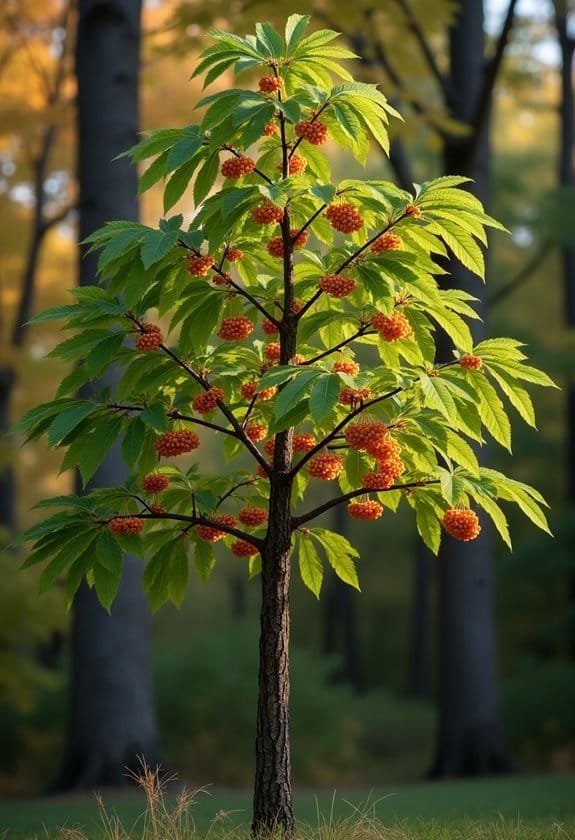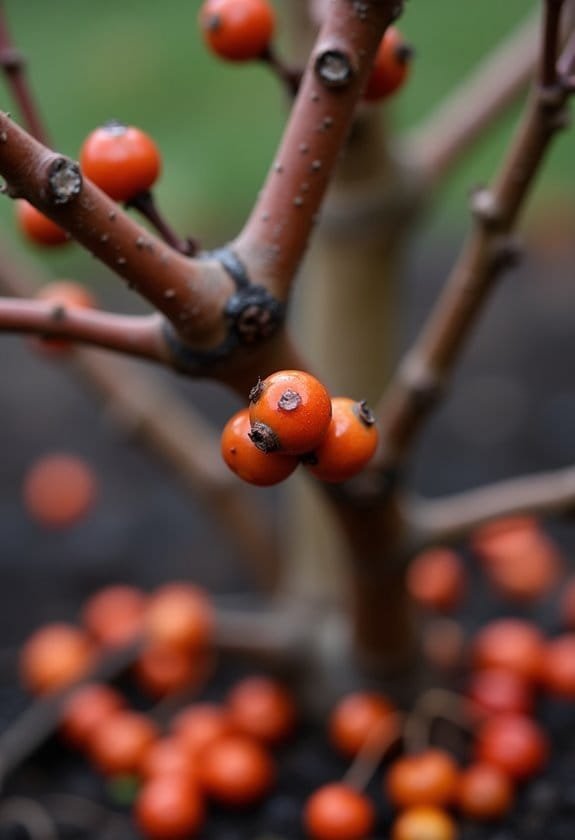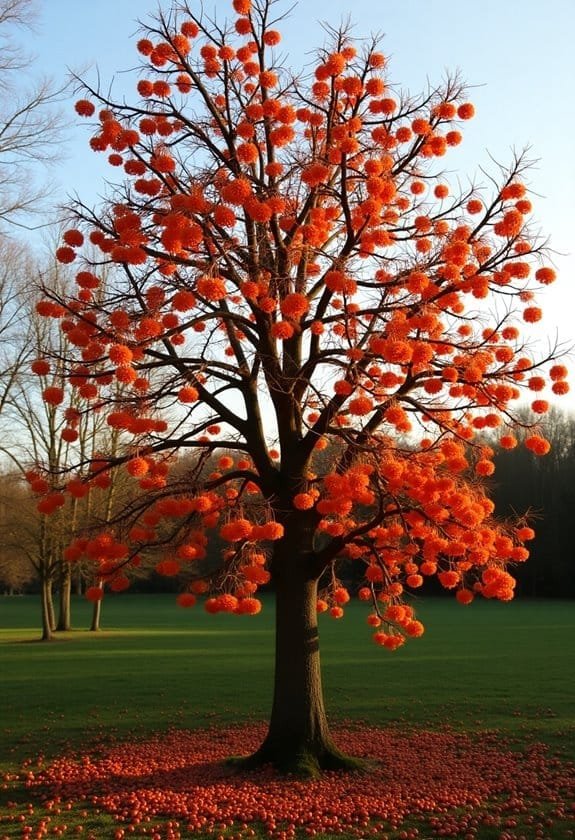Sorbus aucuparia, commonly known as mountain ash or rowan, thrives in Europe and Asia's cooler regions, displaying distinctive pinnate leaves and vibrant orange-red berries. This resilient tree grows best in USDA zones 3-6, tolerating temperatures down to -30°C while requiring full sun and well-drained, acidic soils. It's culturally significant, historically planted near homes as protection against evil in Norse and Celtic traditions. The tree's ecological importance stems from its role as a food source for over 60 bird species and various mammals, while its white flowers support essential pollinators. Understanding this remarkable species reveals a fascinating intersection of cultural heritage and ecological value.
Main Points
- Sorbus aucuparia is a deciduous tree native to Europe and Asia, known for its distinctive orange-red berries and pinnate leaves.
- The tree holds deep cultural significance in Norse and Celtic traditions, historically planted near homes as protection against evil spirits.
- Mountain ash grows best in full sun, tolerates cold temperatures to -30°C, and prefers well-drained, acidic soils with pH 5.0-6.5.
- White flowers bloom in May-June, attracting pollinators like bees and flies, before developing into bright berries from August to October.
- The tree provides vital food for wildlife, supporting approximately 60 bird species and various mammals throughout different seasons.
Introduction

Sorbus aucuparia, commonly known as mountain ash or rowan, stands as a remarkable member of the Rosaceae family native to Europe and Asia's cooler regions.
This deciduous tree combines both ornamental and cultural significance, featuring distinctive pinnate leaves and producing vibrant clusters of orange-red berries that grace its branches from late summer through autumn.
The rowan's adaptability to various growing conditions and its historical importance in folklore have secured its place as a valued species in both natural woodlands and cultivated landscapes.
Common Name
Known widely as the rowan tree or mountain ash, Sorbus aucuparia carries several common names that reflect its cultural and historical significance. Among its most recognized appellations, the name "rowan" traces its linguistic roots to the Old Norse word "raun," which emphasizes the tree's deep connection to Nordic heritage and maritime traditions.
The species is also frequently referred to as the Amur mountain-ash in certain regions, while the evocative name "quickbeam" adds to its rich nomenclature. These diverse common names have evolved across different cultures and geographical locations, each capturing unique aspects of the tree's characteristics or cultural importance.
The designation "mountain ash" derives from the tree's ability to thrive in elevated terrain and its ash-like compound leaves, though it bears no botanical relation to true ash trees. Throughout history, these various names have become deeply interwoven with local traditions and folklore, particularly in European cultures where the tree was often planted near dwellings and sacred spaces as a protective talisman against malevolent forces.
Scientific Name
The scientific name Sorbus aucuparia represents a well-documented taxonomic classification within the Rosaceae family, where it was formally established after being reclassified from its earlier designation as Pyrus aucuparia. This binomial nomenclature precisely identifies the species among its botanical relatives, reflecting its distinct characteristics and evolutionary lineage.
The genus Sorbus encompasses numerous species sharing similar morphological features, with Sorbus aucuparia standing out for its distinctive combination of pinnate leaves bearing 4 to 9 leaflet pairs and its clusters of vibrant pomes.
The species epithet "aucuparia" derives from classical Latin, suggesting its historical association with bird-catching, which aligns with its ecological significance as an essential food source for approximately 60 bird species.
This scientific classification has proven particularly valuable in distinguishing Sorbus aucuparia from other members of the Rosaceae family, especially given its broad geographic distribution across Europe, Asia, and northern Africa.
The taxonomic placement accurately reflects the species' unique adaptations to acidic soils and its characteristic symbiotic relationships with arbuscular mycorrhizal fungi, which facilitate nutrient absorption through its root system.
Overview
Throughout the diverse landscapes of Europe and Asia, rowan stands as a remarkable deciduous tree distinguished by its vibrant orange-red berries and elegant pinnate foliage. This adaptable species, reaching heights of 5 to 15 meters, flourishes in well-drained, acidic soils and has established itself as a common sight in light woodlands and along rural thoroughfares.
From May to June, the rowan showcases dense clusters of yellowish-white flowers arranged in corymbs, attracting essential pollinators such as bees and flies. These blossoms transform into the tree's signature berry clusters, which serve as a significant food source for an impressive array of wildlife, including more than 60 bird species and various mammals.
Beyond its ecological significance, the rowan holds deep cultural importance, particularly in Norse and Celtic traditions, where it's revered as a protective symbol against malevolent forces. The tree's practical applications extend into both culinary arts and traditional medicine, demonstrating its versatility beyond its ornamental appeal.
This combination of ecological value, cultural significance, and practical utility has cemented the rowan's status as a remarkable species in northern hemisphere ecosystems.
Key Features
Sorbus aucuparia stands as a striking tree reaching heights between 5 to 15 meters, featuring a rounded crown and characteristically multiple trunks.
The tree's distinctive bark undergoes a remarkable transformation, shifting from smooth and yellowish-gray in its youth to a weathered gray-black with lengthwise fissures in maturity.
From May through June, it produces abundant clusters of yellowish-white flowers that give way to vibrant orange or scarlet pomes, which ripen between August and October.
Growth Size
As a mature specimen, mountain ash reaches heights between 5 to 15 meters (15 to 50 feet) with a loose, roundish crown formation. This moderate-growing species typically achieves its full height within a decade, displaying a distinctive multi-trunked growth pattern that becomes more pronounced with age.
The tree's physical development is marked by notable changes in its bark characteristics, shifting from a smooth, yellowish-gray surface in its juvenile stage to a more textured gray-black appearance as it matures. These changes are accompanied by the formation of distinctive longitudinal fissures that create a characteristic pattern along the trunk's surface.
During the growing season, the mountain ash's size is complemented by its impressive floral display, producing dense clusters of approximately 250 yellowish-white flowers from May through June.
These blossoms give way to substantial clusters of round pomes, which develop and ripen between August and October, adding to the tree's visual mass and creating a striking silhouette against the landscape.
Appearance
The distinctive appearance of mountain ash encompasses several key features that make it easily recognizable in landscapes. This elegant tree develops a loose, roundish crown often supported by multiple trunks, creating a characteristic silhouette that reaches heights between 5 to 15 meters.
The rowan's bark undergoes a remarkable transformation throughout its life cycle, beginning with a smooth, silvery-gray surface in its youth before maturing into a darker gray-black shade marked by distinctive lengthwise fissures.
Its compound leaves present a sophisticated arrangement, with 4 to 9 pairs of serrated leaflets extending up to 20 centimeters in length, creating an intricate canopy pattern.
During the flowering season from May to June, mountain ash produces dense clusters of yellowish-white blossoms, with each corymb hosting approximately 250 individual flowers.
These blooms later give way to perhaps the tree's most striking feature: vibrant orange to scarlet pomes that emerge from August to October, showcasing a unique star-shaped internal structure that houses one to two seeds.
Flowering Season
Mountain ash's spring spectacle unfolds during May and June, when dense clusters of yellowish-white flowers blanket the tree's crown. These intricate floral displays consist of corymbs, each containing approximately 250 individual blossoms arranged in flat-topped clusters that showcase the tree's reproductive architecture.
The distinctive five-petaled flowers, while emitting a somewhat disagreeable scent, serve as essential feeding stations for local pollinator populations. During the flowering season, these blossoms transform into bustling ecological hubs, attracting diverse insect visitors, particularly bees and flies, which play important roles in the pollination process.
The white flowers provide abundant resources in the form of nectar and pollen, supporting the surrounding ecosystem's intricate web of relationships. This period of intense activity sets the stage for the tree's next phase of development, as successful pollination leads to fruit formation.
From August through October, the fertilized flowers gradually develop into berries, their color shifting from pale yellow to brilliant orange or scarlet, marking the completion of the reproductive cycle.
Growing Requirements

Sorbus aucuparia flourishes in full-sun locations where it receives at least six hours of direct sunlight daily, essential for robust growth and abundant flowering.
The species adapts remarkably well to various soil conditions but shows ideal development in well-drained, acidic environments that maintain consistent moisture levels throughout the growing season.
These hardy trees demonstrate impressive resilience across USDA zones 3 through 6, tolerating cold temperatures while requiring sufficient water during establishment, though they can withstand moderate drought once mature.
Light
Growing in full sun conditions is essential for Sorbus aucuparia, which requires at least 6 hours of direct sunlight daily to reach its full potential. While the tree demonstrates remarkable adaptability to various environments, ideal light exposure plays a vital role in its development and overall health, particularly in temperate regions where sunlight may be less intense.
Although mountain ash can tolerate partial shade, its growth patterns and vigor are strikingly enhanced when exposed to abundant natural light. The species' impressive ability to thrive at higher altitudes, where light intensity can vary considerably, showcases its environmental versatility.
In regions with shorter daylight hours or frequent cloud cover, positioning the tree in locations that maximize available sunlight becomes particularly important for maintaining robust growth. The tree's frost-hardy nature complements its light requirements, allowing it to flourish in cooler climates where other sun-loving species might struggle.
This combination of cold tolerance and light adaptation makes Sorbus aucuparia an excellent choice for gardens and landscapes in northern regions, where it can capitalize on available sunlight while withstanding temperature fluctuations.
Soil
The soil composition plays a fundamental role in supporting the robust growth that abundant sunlight enables in Sorbus aucuparia. This adaptable fruit tree demonstrates a marked preference for well-drained, acidic soils that maintain consistent moisture levels without becoming waterlogged.
While rowan trees can tolerate various soil conditions, they exhibit ideal growth and fruit production in nutrient-poor, sandy substrates that might challenge other ornamental species. Their remarkable ability to establish themselves in disturbed areas stems from their capacity to thrive in loose, uncompacted soil structures that facilitate proper root development.
The species' inherent frost hardiness complements its soil adaptability, allowing it to flourish in cool, moist environments that would typically limit other trees' growth potential. In locations where these ideal soil conditions converge, particularly those offering both adequate drainage and moisture retention, Sorbus aucuparia develops into a more vigorous specimen with enhanced longevity.
This resilient tree's soil preferences reflect its natural habitat in mountainous regions, where it has evolved to prosper in less fertile conditions while maintaining steady growth rates.
Water
Proper moisture management stands at the heart of successful Sorbus aucuparia cultivation. The tree requires consistent watering practices that maintain soil dampness without creating waterlogged conditions, which could potentially damage its sensitive root system.
During the vital establishment period, newly planted rowans demand particular attention to their water needs. Regular irrigation in the first two years helps develop robust root networks that will sustain the tree throughout its lifetime.
Once established, the tree demonstrates moderate resilience to dry conditions, though supplemental watering remains essential during prolonged drought periods.
The growing season presents heightened moisture requirements, especially when temperatures soar. A balanced approach to watering proves essential, as both excessive and insufficient moisture can compromise the tree's health.
While Sorbus aucuparia appreciates consistent moisture, its roots must never sit in saturated soil. Implementing proper drainage solutions and monitoring soil moisture levels helps strike the best balance between hydration and aeration, ensuring the tree maintains vigorous growth and abundant fruit production throughout the season.
Temperature
Natural temperature tolerance makes Sorbus aucuparia an exceptional choice for temperate climates, particularly in regions with cooler conditions. The remarkable adaptability of mountain ash allows it to withstand temperatures plummeting to an impressive -30°C (-22°F), demonstrating its robust cold-hardiness capabilities.
This resilient species thrives within USDA hardiness zones 3 through 6, making it an ideal selection for gardens and landscapes in northern regions.
The tree's temperature requirements align perfectly with its need for full sun exposure, as it demands at least six hours of direct sunlight daily to maintain peak growth patterns.
During the growing season, mountain ash demonstrates remarkable versatility in adapting to varying temperature fluctuations while maintaining its vigor. This adaptability, combined with its tolerance for diverse soil conditions, enables the species to establish itself successfully across a range of microclimates within its preferred temperature zones.
While it shows impressive cold tolerance, the tree performs best in areas where summer temperatures remain moderate, typical of temperate regions where it naturally occurs.
Pollinator Criteria
The rowan tree's dense corymbs of yellowish-white flowers serve as prolific nectar and pollen stations, attracting a diverse array of pollinating insects during the May-June flowering period.
Bees and flies are particularly drawn to these floral clusters, which can feature up to 250 individual blooms arranged in conspicuous displays.
The successful pollination of these flowers proves essential for the tree's reproductive cycle, leading to the development of the characteristic red berries in late summer while supporting the broader ecosystem's pollinator populations.
Attracted Pollinators
Sorbus aucuparia's white flowers serve as powerful pollinator magnets during the May-June flowering season, attracting diverse insect species, particularly bees and flies. The tree's dense corymbs, each containing approximately 250 flowers, create an abundant nectar buffet that proves irresistible to these beneficial insects.
Despite emitting a slightly unpleasant odor, the flowers successfully attract specialized pollinators that have adapted to such scents, demonstrating nature's remarkable efficiency in matching plants with their ideal pollination partners.
The symbiotic relationship between rowan trees and arbuscular mycorrhizal fungi further enhances this ecological partnership by improving the tree's nutrient absorption, which in turn supports healthier flower production and nectar quality.
This intricate pollination system yields significant benefits beyond the immediate needs of the pollinators themselves. The successful fertilization of rowan flowers leads to the development of vibrant orange-red berries, which become essential autumn sustenance for various bird species.
This interconnected chain of ecological relationships highlights the rowan's important role in supporting both insect and avian biodiversity within its habitat.
Pollination Method
Successful pollination of rowan trees relies heavily on the synchronized efforts of bees and flies during the May-June flowering period. The dense clusters of yellowish-white flowers serve as natural beacons, attracting these crucial pollinators through both visual and chemical signals.
The flowers' strategic production of nectar acts as a powerful attractant, ensuring consistent pollinator visits throughout the blooming season.
The pollination process demonstrates remarkable efficiency, as insects move systematically between the abundant flower clusters. When visiting the blossoms in search of nectar, pollinators inadvertently transfer pollen between flowers, facilitating cross-pollination that's essential for genetic diversity and reproductive success.
This intricate process culminates in the development of the tree's characteristic round pomes, which begin forming shortly after successful pollination occurs.
The adaptability of Sorbus aucuparia's pollination strategy becomes particularly evident in its ability to support various pollinator species across different habitats.
This flexibility in pollination mechanisms has enabled the species to establish itself successfully across diverse ecological zones, contributing notably to local ecosystem dynamics and biodiversity maintenance.
Care & Maintenance

Successful cultivation of Sorbus aucuparia starts with selecting a planting site that offers full sun exposure and well-draining, acidic soil with a pH between 5.0 and 6.5.
Regular maintenance throughout the growing season involves consistent watering during dry spells, annual late-winter pruning to shape the crown, and maintaining a 3-inch layer of organic mulch around the base while keeping it away from the trunk.
The rowan tree flourishes when planted alongside compatible companions such as spring bulbs and shade-tolerant perennials, which create a harmonious understory without competing for essential nutrients or moisture.
Planting Tips
Growing a healthy Rowan tree requires careful attention to its basic needs and environmental preferences. When considering planting tips for Sorbus aucuparia, selecting the right location is paramount to guarantee ideal growth and development throughout the tree's lifecycle.
The key to successful establishment lies in preparing acidic, well-draining soil before red rowan trees were planted, as this species shows particular sensitivity to waterlogged conditions. A location that receives at least six hours of direct sunlight daily will promote robust growth and abundant fruit production.
When digging the planting hole, make it twice the width of the root ball but maintain the same depth, guaranteeing the root collar sits slightly above soil level. Incorporating organic matter into the backfill soil enhances drainage and provides essential nutrients during the critical establishment phase.
After planting, apply a 2-3 inch layer of mulch around the base, maintaining a clear space of several inches around the trunk to prevent moisture-related issues. Regular watering during the first growing season helps develop a strong root system, though care should be taken to avoid oversaturation.
Ongoing Care
Throughout the life of a Sorbus aucuparia, proper maintenance assures its vigor and longevity. These ash trees require consistent attention to thrive, beginning with a carefully monitored watering schedule that maintains soil moisture without creating waterlogged conditions, particularly during dry spells.
The ongoing care of Sorbus aucuparia involves several key practices that work in concert to promote ideal health. Regular pruning during late winter or early spring serves as a cornerstone of maintenance, allowing gardeners to shape the crown while removing compromised branches that might otherwise harbor diseases.
Vigilant monitoring for common threats, such as wood-boring insects and fungal infections, enables early intervention before problems escalate into serious complications. Regarding nutrition, these trees benefit from an annual application of balanced fertilizer as spring emerges, providing essential nutrients that fuel robust growth and development.
While established specimens demonstrate admirable resilience, young trees especially require attentive care during their formative years. Success hinges on providing six hours of direct sunlight daily, coupled with proper soil conditions that facilitate both drainage and nutrient uptake.
Suggested Companions
When planning a Sorbus aucuparia garden, thoughtful companion planting sets up the foundation for a thriving ecosystem. Trees such as hazelnuts, oaks, and birches make excellent companion plants, as they share the rowan's preference for acidic, well-drained soils while creating a harmonious canopy structure.
Strategic spacing proves essential when selecting companion plants, as the rowan's impressive height of 5 to 15 meters and spreading crown demand careful consideration. Ground-level companions like ferns and heathers serve dual purposes, maintaining soil moisture while suppressing unwanted vegetation beneath the tree's canopy.
The integration of flowering plants, particularly lavender and yarrow, enhances the garden's pollinator population, directly benefiting the rowan's fruit production.
Monitoring the health of companion plants requires vigilance, particularly regarding diseases like fireblight and silver leaf that can affect the rowan. A thoughtfully designed companion planting scheme creates multiple vegetation layers, mimicking natural forest environments where mountain ash typically thrives.
This layered approach not only maximizes space utilization but also promotes biodiversity and strengthens the overall resilience of the garden ecosystem.
Common Issues
Sorbus aucuparia faces several significant health challenges, with fireblight and European mountain ash ringspot-associated virus ranking among its most serious threats.
The tree's vulnerability extends to silver leaf disease, which manifests through branch dieback and deteriorating crown health, while insect infestations, particularly from wood-boring pests, can exploit already weakened specimens.
Effective management requires vigilant monitoring for early warning signs, coupled with prompt implementation of control measures such as proper pruning techniques and protection against deer browsing in high-risk areas.
Pests/Diseases
Like many ornamental trees, rowan faces several notable pest and disease challenges that can impact its health and longevity. Among the most troublesome pests are wood-boring insects and aphids, which can considerably weaken the tree's structural integrity and make it more susceptible to secondary infections.
Fireblight poses a particularly serious threat to Sorbus aucuparia, especially during warm, humid conditions when the bacterium thrives and causes branches to wilt and die back. The European mountain ash ringspot-associated virus presents another formidable challenge, manifesting through distinctive leaf mottling patterns and gradually diminishing the tree's overall vigor.
Additionally, silver leaf disease can prove devastating if left unchecked, as it progresses from telltale silvery leaves to extensive branch dieback.
Fortunately, proper management strategies can help protect rowan trees from these threats. Regular monitoring for early signs of infection, maintaining well-drained soil conditions, and ensuring adequate spacing between trees create an environment less conducive to pest and disease proliferation.
When problems are detected early, targeted interventions can often prevent severe damage and preserve the tree's health.
Solutions
The rowan tree's most common issues can be effectively managed through a combination of preventive measures and targeted interventions. Regular monitoring and swift action form the cornerstone of successful disease management, particularly when dealing with fireblight and silver leaf infections.
For fireblight control, implementing a rigorous pruning regimen during dormant seasons helps minimize disease spread, while sterilizing tools between cuts prevents cross-contamination. When European mountain ash ringspot-associated virus is detected, affected trees require careful isolation from healthy specimens, and surrounding soil should be tested to optimize growing conditions.
To combat silver leaf disease, pruning must be conducted during dry weather conditions, and all infected material should be promptly removed and destroyed.
Protection against deer browsing involves installing sturdy fencing at least 6 feet high around young trees or applying commercial repellents every few weeks during peak browsing seasons.
To enhance overall resilience, maintaining proper soil pH between 5.0 and 7.0, ensuring adequate drainage, and applying balanced fertilization can help trees withstand various stressors and resist disease development.
Summary

Commonly found across Europe and parts of Asia, rowan (Sorbus aucuparia) is a deciduous tree reaching heights of 5-15 meters that's known for its distinctive clusters of orange-red berries. The tree showcases dense corymbs of yellowish-white flowers during the late spring months, which transform into vibrant pomes that serve as essential sustenance for wildlife throughout autumn.
This adaptable species demonstrates remarkable versatility in its habitat preferences, flourishing in well-drained, acidic soils within temperate regions. As a pioneer species, rowan plays a significant role in ecological succession, particularly in disturbed areas and light woodlands.
The tree's ecological importance extends beyond its pioneer status, as it provides essential nutrition for more than 60 bird species and various mammals.
Beyond its natural importance, rowan holds deep cultural significance in European folklore, where it's traditionally planted near dwellings as a protective talisman. The tree's berries, while initially bitter, can be transformed into culinary delights such as jellies and syrups through proper processing, bridging the gap between ecological resource and human utility.


